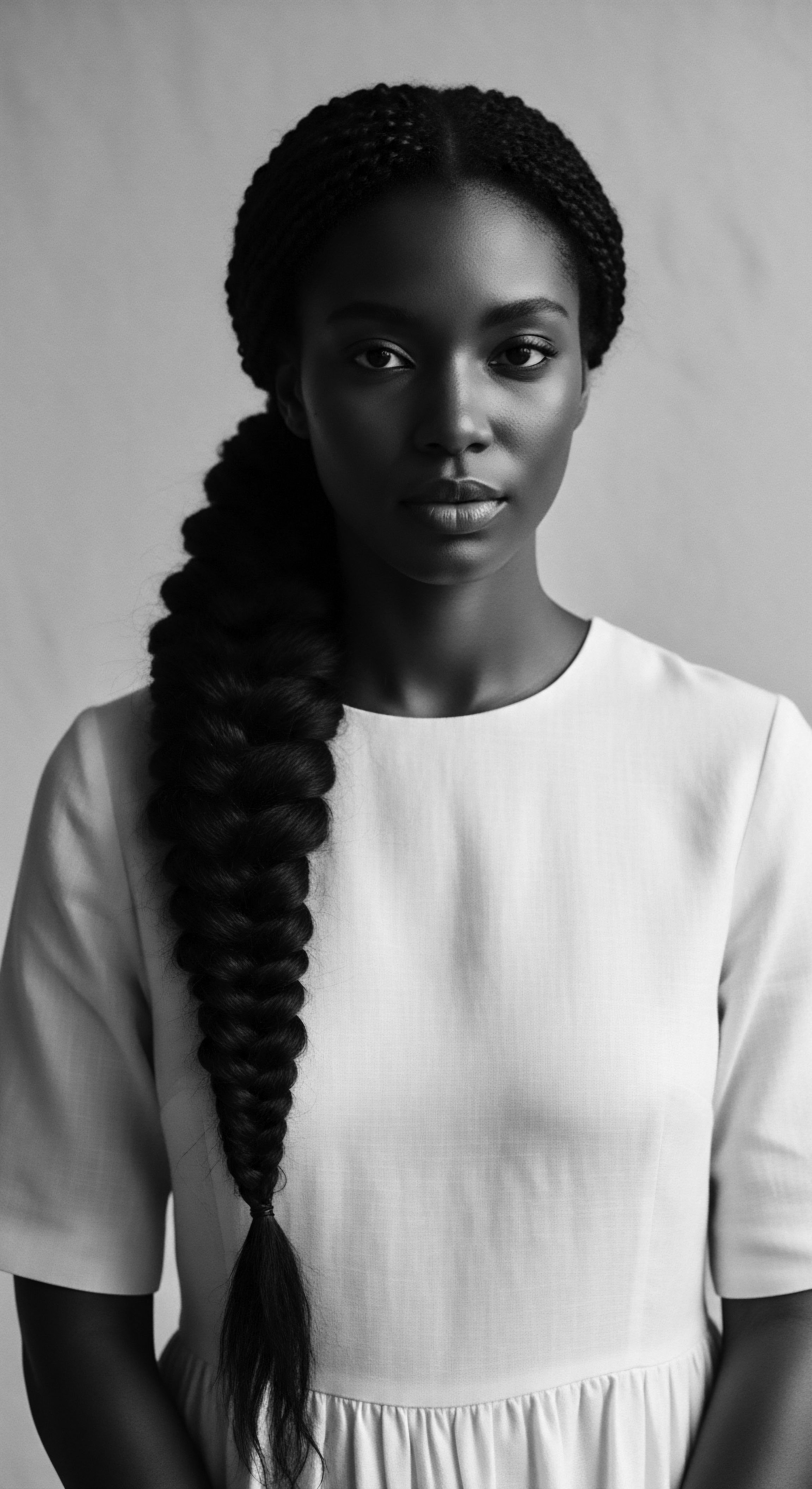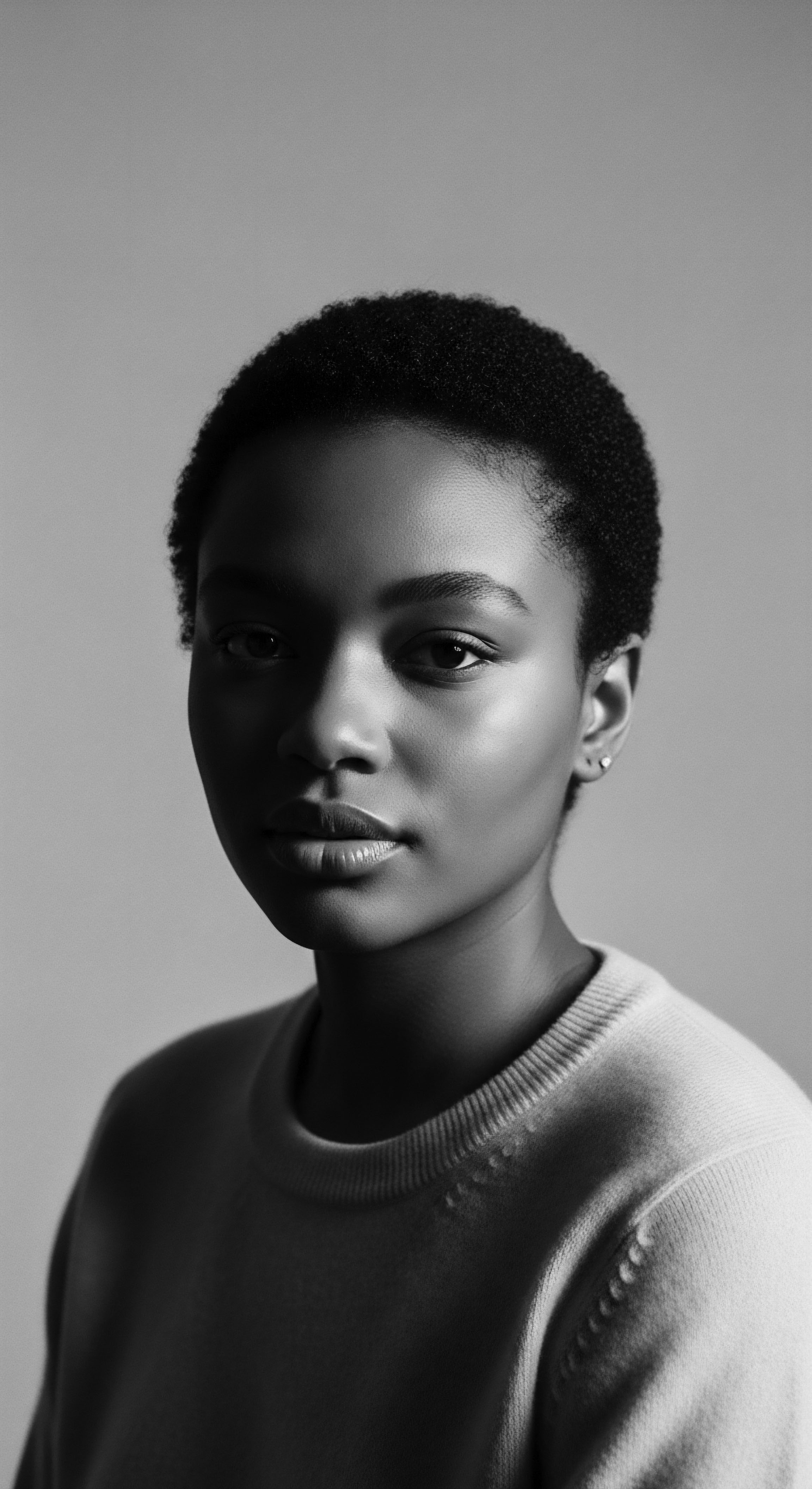
Roots
Consider, for a moment, the very fiber of who we are, woven into the strands that crown our heads. For generations beyond memory, Black and mixed-race communities have understood hair not merely as biological outgrowth, but as a living legacy, a conduit to ancestry, and a declaration of self. Within this profound understanding, the prioritization of hydration for textured hair emerges not as a mere beauty tip, but as an elemental truth, observed, lived, and passed down through the ages. It is a wisdom born from a deep intimacy with the hair itself, a response to its very being, its spiral, its coil, its thirst.
From the sun-drenched plains of West Africa to the humid Caribbean islands, and across the diaspora, our forebearers discerned the particular needs of textured hair long before microscopes revealed its intricate architecture. They saw its tendency toward dryness, its delicate nature when mishandled, and its radiant strength when nourished. This observational science, honed over centuries, formed the bedrock of practices that kept hair vibrant, resilient, and ready to tell its story. The understanding that water, in its myriad forms, held a sacred power for these strands was not a theory; it was a daily, lived experience.

What Defines Textured Hair’s Unique Hydration Needs?
The physical makeup of textured hair, often characterized by its elliptical shape and helical growth pattern, fundamentally influences its moisture dynamics. Unlike straighter hair types, which allow natural oils from the scalp to glide down the hair shaft with relative ease, the twists and turns of coils create natural barriers. This structural reality means that sebum, our scalp’s protective oil, struggles to coat the entire length of the strand.
Consequently, textured hair often experiences greater porosity and a heightened predisposition to moisture loss, making it inherently more vulnerable to environmental stressors without consistent external support. This was a truth intuitively understood by ancestral hands.
The ancestral gaze recognized that hair was an extension of the body’s well-being, impacted by diet, climate, and spiritual harmony. They noted that hair, when parched, became brittle, prone to breaking, and less amenable to the styling practices that held such deep cultural significance. The act of providing moisture, therefore, became a preventative measure, a way to maintain the hair’s integrity and ensure its continued role as a symbol of health and communal connection.
Ancestral wisdom intuitively grasped that the coiled structure of textured hair created a natural predisposition to dryness, necessitating consistent moisture for vitality.

The Ancient Wisdom of Hair’s Architecture
Even without modern scientific vocabulary, the practical understanding of hair anatomy was clear. The outer layer, the cuticle, with its shingle-like cells, dictates how well moisture is retained. Ancestors, through trial and observation, learned that certain preparations could help these “shingles” lie flat, sealing in precious water.
They understood the hair shaft’s internal layers – the cortex and medulla – were where resilience resided, and that a hydrated cortex was a strong cortex. This profound, unspoken understanding guided their material choices and application techniques.
Consider the daily lives rooted in agricultural cycles and close-knit communities. Hair was exposed to elements, dust, and the demands of labor. A well-hydrated mane was not simply an aesthetic choice; it spoke to practicality, comfort, and the overall health of the individual within their environment. The practices that evolved were thus a direct response to both the hair’s inherent characteristics and the realities of ancestral living.
- Baobab Oil ❉ Extracted from the majestic baobab tree, this oil, rich in omega-3 fatty acids, was recognized for its deep penetration and softening qualities, aiding in cuticle health.
- Shea Butter ❉ From the karité tree, this butter provided a dense, protective seal against moisture loss, particularly vital in arid climates. Its emollient properties were highly valued.
- Aloe Vera ❉ The mucilaginous gel from the aloe plant offered immediate hydration and soothing properties for the scalp and strands, a universal healer in many traditional settings.
These plant-derived components, readily available within various ancestral landscapes, formed the backbone of hydrating regimens. Their use was a testament to sophisticated botanical knowledge, passed down orally and through direct apprenticeship.

Ritual
The understanding of textured hair’s need for hydration was not confined to abstract knowledge; it manifested in daily and weekly rituals, in the tender touch of a mother, the shared space of communal grooming, and the purposeful creation of formulations passed down through generations. These acts were imbued with meaning, transforming simple care into sacred practice. The rhythmic application of oils, butters, and infused waters became a living prayer for health and well-being, an affirmation of self and a connection to those who came before.
Think of the evening gatherings, perhaps under the soft glow of firelight, where hands moved with practiced grace, detangling and adorning. These were not solitary acts but communal expressions of care. The hydration element was central here, preparing the hair for manipulation, softening it for intricate styles, and protecting it through the night. The very tools used—wide-toothed combs carved from wood or bone, gourd containers for mixing concoctions—speak to a mindful, intentional approach.

How Did Ancestral Hands Apply and Seal Hydration?
Ancestral practices recognized a layered approach to moisture, often beginning with water itself. Rainwater, collected for its softness, or infusions of herbs, became the primary hydrating agents. These were followed by lipid-rich substances, acting as emollients and occlusives, to lock in the water. The layering technique, now often referred to as “LOC” (liquid, oil, cream) or “LCO” (liquid, cream, oil) in modern hair care, has deep ancestral roots.
The liquid, whether pure water or a botanical brew, provided direct hydration. The oil, often a light, penetrating variety like coconut or moringa, supported the hair shaft. The heavier butter, such as shea or cocoa, then sealed the cuticle, preventing evaporation.
The deliberate process of moistening before detangling or styling was universal. Dry, brittle hair would snap, causing pain and damage. By introducing water and then a lubricating oil or butter, the hair became pliable, reducing friction and breakage.
This protective foresight speaks volumes about the value placed on hair health and retention. It wasn’t about quick fixes; it was about sustained health through consistent, methodical hydration.
Layered application of water followed by oils and butters was a foundational ancestral technique to seal in hydration and maintain hair pliability.

The Art of Formulation ❉ Botanical Science in Action
Ancestral communities were master botanists, understanding the specific properties of local plants. They knew which leaves yielded mucilage (slippery, hydrating compounds), which seeds produced softening oils, and which roots offered cleansing abilities. These ingredients were often combined in precise ways, reflecting generations of experimentation and refinement. For instance, the use of okra or flaxseed for their gel-like consistency to provide slip and hydration, or specific leaves crushed and steeped to create conditioning rinses.
Consider the use of fermented rice water, a practice well-documented in regions such as the Yao tribe in Huangluo Village, China. While not African, it illuminates a shared ancestral understanding across various cultures of how water, combined with natural fermentation processes, could transform hair strength and length, largely through enhancing moisture retention and elasticity (M. P. S.
Bhat & K. K. S. Kumar, 2017). This practice, rich in inositol, provides a powerful example of how deep observation led to highly effective, albeit scientifically unquantified, hydration techniques.
| Element Type Liquids/Hydrators |
| Ancestral Sources/Examples Rainwater, infused herbal waters (e.g. hibiscus, rosemary), fermented rice water |
| Benefit for Textured Hair Hydration Direct moisture infusion; softens hair cuticle, prepares for detangling, enhances shine. |
| Element Type Emollients/Oils |
| Ancestral Sources/Examples Coconut oil, palm oil, moringa oil, argan oil (North Africa) |
| Benefit for Textured Hair Hydration Lubricates the hair shaft, reduces friction, aids in detangling, provides some sealing. |
| Element Type Occlusives/Butters |
| Ancestral Sources/Examples Shea butter, cocoa butter, mango butter |
| Benefit for Textured Hair Hydration Forms a protective barrier on the hair surface, preventing moisture loss, providing intense softness. |
| Element Type Conditioners/Gels |
| Ancestral Sources/Examples Aloe vera gel, okra mucilage, flaxseed gel |
| Benefit for Textured Hair Hydration Provides slip for detangling, adds sustained moisture, defines curl patterns. |
| Element Type These ancestral components provided a comprehensive system for maintaining hydration, demonstrating an advanced, empirical understanding of textured hair needs. |

Relay
The ancestral prioritization of hydrating textured hair stands as a testament to the resilience of cultural knowledge, passed not merely as technique, but as a living inheritance. Through the passage of time, across continents and generations, these care practices became vital conduits of identity, a silent language spoken through hands and strands. The emphasis on moisture, therefore, transcended the physical; it became an act of self-preservation, a form of resistance, and a celebration of a heritage that refused to be erased.
The diaspora, in all its complexity, carried these practices, adapting them to new environments and available resources, yet always maintaining the core principle ❉ textured hair thrives on hydration. In the face of imposed beauty standards and the systematic denigration of Black hair, the act of tending to one’s coils with ancestral remedies became a profound political statement, a quiet defiance that upheld dignity and lineage. This deliberate care affirmed the inherent beauty of hair that defied eurocentric ideals, solidifying its place as a symbol of cultural pride and continuity.

How Did Hydration Practices Become Tied to Identity and Resistance?
During periods of profound social upheaval, such as slavery and its aftermath, hair care rituals, particularly those focused on hydration and protective styling, served as critical mechanisms for cultural survival. Stripped of names, languages, and lands, enslaved Africans held onto their hair as a last vestige of identity and connection to their heritage. The communal grooming sessions, often involving the application of greases and oils to combat dryness and manageability, became covert spaces for storytelling, shared grief, and the transmission of ancestral knowledge (Byrd & Tharps, 2014). Hydrated, well-maintained hair was a quiet assertion of humanity and a refusal to conform to dehumanizing conditions.
This legacy extends into contemporary Black and mixed-race experiences. The natural hair movement, a resurgence of embracing textured hair in its unaltered state, draws deeply from this ancestral well. It acknowledges that the health and appearance of coiled strands are intimately linked to historical practices of hydration and protection. The ongoing conversation around textured hair care is, at its heart, a dialogue about heritage, self-acceptance, and reclaiming narratives that were once suppressed.
Hair care rituals, particularly hydration-focused practices, became powerful acts of cultural preservation and resistance amidst historical oppression.

Validating Ancestral Wisdom Through Modern Understanding
Contemporary trichology and cosmetic science now provide empirical validation for what ancestral practices knew intuitively. Research into the hair shaft’s cuticle integrity, the optimal pH balance for sealing moisture, and the molecular structure of various botanical oils confirms the efficacy of age-old methods. For example, studies on the permeability of the stratum corneum (a parallel to the hair’s cuticle) show that a healthy lipid barrier, often aided by specific fatty acids found in traditional butters like shea, is essential for minimizing transepidermal water loss (TEWL) (D. J.
V. R. F. W.
J. and R. J. R.
P. D. F. 2004). This scientific lens confirms the ancestral genius in choosing ingredients that effectively managed moisture.
The science highlights how the unique hydrogen bonding within the keratin structure of hair, particularly textured hair, responds to water. When hair is adequately hydrated, these bonds are more flexible, making the hair less prone to breakage during manipulation. The ancestral practices of applying hydrating liquids before protective styles like braids or twists ensured this critical flexibility, extending the life of the style and preserving the health of the strands.
- Post-Shampoo Hydration ❉ Immediately after cleansing, when the hair cuticle is open, ancestral practices prioritized the application of water or herbal rinses to infuse moisture.
- Layering of Lipids ❉ Following the liquid, oils and then heavier butters were applied to seal the water within the hair shaft, a method confirmed by modern understanding of occlusive barriers.
- Protective Styling Integration ❉ Hydration was a prerequisite for styling, softening the hair to prevent breakage during intricate braiding or twisting, ensuring the longevity and health of protective styles.
The relay of this knowledge, from generation to generation, has ensured that textured hair care is not a fleeting trend but a deeply rooted tradition. It continues to guide product development, inform personal routines, and shape the communal dialogue around hair, emphasizing its inherent connection to the past, present, and future of identity. The wisdom of why ancestral practices prioritized hydrating textured hair stands as an enduring testament to ingenuity and a profound connection to the physical and spiritual self.

Reflection
To ponder the foundational care of textured hair is to gaze into a living archive, where each strand holds the memory of ancestral hands, the whispered wisdom of generations, and the resilient spirit of a people. The deep, abiding commitment to hydrating textured hair, so evident in practices across the diaspora, is more than a technical solution to a biological reality. It is a philosophy, a quiet rebellion, and a profound declaration of self-worth born from understanding and cherishing one’s distinct heritage.
The journey from elemental biology to communal ritual, and then to a vibrant expression of identity, underscores the enduring truth of textured hair’s intimate connection to water. This link, recognized by our forebearers and affirmed by contemporary science, continues to shape our understanding of holistic wellness, reminding us that true care is rooted in honoring the inherent qualities of what has been given. It calls us to listen to the whispers of ancient wisdom, to touch our strands with reverence, and to carry forward a legacy of care that celebrates every spiral, every coil, every unique bend. The soul of a strand, indeed, holds within it the history of a boundless spirit, perpetually refreshed by the waters of memory and the promise of tomorrow.

References
- Byrd, A. D. & Tharps, L. D. (2014). Hair Story ❉ Untangling the Roots of Black Hair in America. St. Martin’s Griffin.
- D. J. V. R. F. W. J. and R. J. R. P. D. F. (2004). Skin Barrier Function. Clinics in Dermatology, 22(3), 195-209.
- M. P. S. Bhat & K. K. S. Kumar. (2017). Asian Herbal Hair Care Formulations ❉ A Review. International Journal of Pharmaceutical Sciences Review and Research, 46(2), 241-247.
- Oyelami, O. A. (2007). The Use of African Medicinal Plants in Hair Care in Nigeria. Journal of Ethnopharmacology, 113(3), 488-492.
- Robbins, C. R. (2012). Chemical and Physical Behavior of Human Hair (5th ed.). Springer Science & Business Media.
